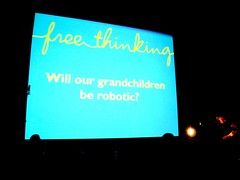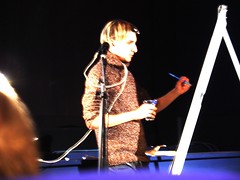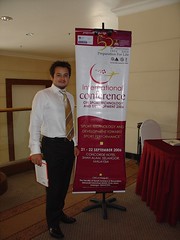Interview by Australian Associated Press while in Brisbane last week. Here's the outcome:
Technology pushes sporting boundaries
http://tvnz.co.nz/view/page/411366/1035788
Dozens of leading professional golfers, including Tiger Woods, have had eye surgery to improve their vision. Some believe it gives them "better than perfect" eyesight and makes the tricky business of reading greens far easier.
Hundreds of American major league baseball pitchers have had surgery to implant stronger tendons from elsewhere in their bodies into their elbows. Many of them testify that they can throw the ball harder and faster than they could before the operation.
Now the day may not be far away when athletes have microscopic-sized devices implanted in their brains to help them perform better.
According to Dr Andy Miah, a British bioethicist, the line between using technology to improve sporting equipment and using it to improve the bodies of its practitioners is becoming increasingly blurred.
"Sports are technologically enabled practises," Miah said.
"We are pushing the limits of the body technologically and creatively - and I think the relationship between those two is quite close.
"People are fascinated with what the body can do in various kinds of performances."
Miah, who was in Brisbane this week to address a conference organised by the Australian Sports Commission, said functional elective surgery in sport is a more immediate issue than the
long-feared emergence of genetically manipulated athletes.
While the World Anti-Doping Agency concentrates on performance-enhancing drugs and worries about so called "gene-doping", it has no provision in its code for surgically enhanced athletes.
Woods, who was so short-sighted his doctor said he could barely count fingers held in front of his face, wore contact lenses early in his career.
He had laser surgery on his eyes in late 1999. After the surgery, which gave him vision rated at 20-15, Woods said the hole looked bigger to him.
Whether or not the surgery had anything to do with it, Woods won seven of the next eight PGA tour events he played in. The following year he began the "Tiger Slam" in which he became the first man to hold all four Majors at the same time.
Woods' surgeon, Dr Mark Whitten, says the eyesight produced by surgically altering the shape of the cornea gives golfers an enhanced three-dimensional view of the shot confronting them. "It
may be better than normal vision," he says.
Others who have had the surgery include Retief Goosen, Vijay Singh, Scott Hoch, Jesper Parnevik, Lee Westwood and Mike Weir.
Around 10% of major league baseball pitchers in the US have had surgery to strengthen their elbows, which come under enormous strain from repeatedly hurling baseballs at 150 kilometres an hour.
The procedure, called ulnar collateral ligament reconstruction (UCR), is widely know as Tommy John surgery after the pitcher who first had it done in 1974.
According to a report published in USA Today, it involves taking a tendon, usually from the wrist or leg, and grafting it into the elbow in a figure-of-eight pattern through tunnels drilled in the
humerus and ulna bones.
The surgery has saved the careers of hundreds of pitchers, and there is evidence that its success rate is encouraging younger pitchers with only minor elbow injuries to seek the surgery to help their careers.
Some pitchers say they come back better than ever.
"I hit my top speed (in pitch velocity) after the surgery," said Kerry Wood, who had the procedure five years ago and now pitches for the Chicago Cubs. "I'm throwing harder, consistently."
Miah believes there is now a new frontier in sporting technology, driven by the convergence of nanotechnology, biotechnology, information technology and cognitive science.
All of these have profound implications for technological and medical developments generally, as well as within sport.
"It seems likely to me that sports will confront the implications of this convergence quite soon.
"We can imagine nanotechnological devices being utilised by athletes to keep them fit ... these are molecular-sized devices that could be inserted into the brain to elicit certain kinds of
physiological modifications."
The technique has already been used to implant molecular-sized devices into the brains of people suffering from Parkinson's disease.
The implants alter the brain's electrical output to help cure the uncontrollable shaking that is the main symptom of the disease.
Technology such as this could have implications in shooting, snooker, archery and other disciplines requiring steady aim.
Miah, who believes genetic manipulation of athletes is not necessarily a bad thing, says the march of technology is throwing up some crucial philosophical questions.
"The development of biotechnology, stem cell research, cloning technology and the like has provoked a kind of moral encounter with what it means to be human and what technology might be doing to alter that.
"If we can develop devices that make it difficult to say these are external to the body, if they're implantable into the body then it becomes much harder to say that they are artificial."







 Forbes
Forbes